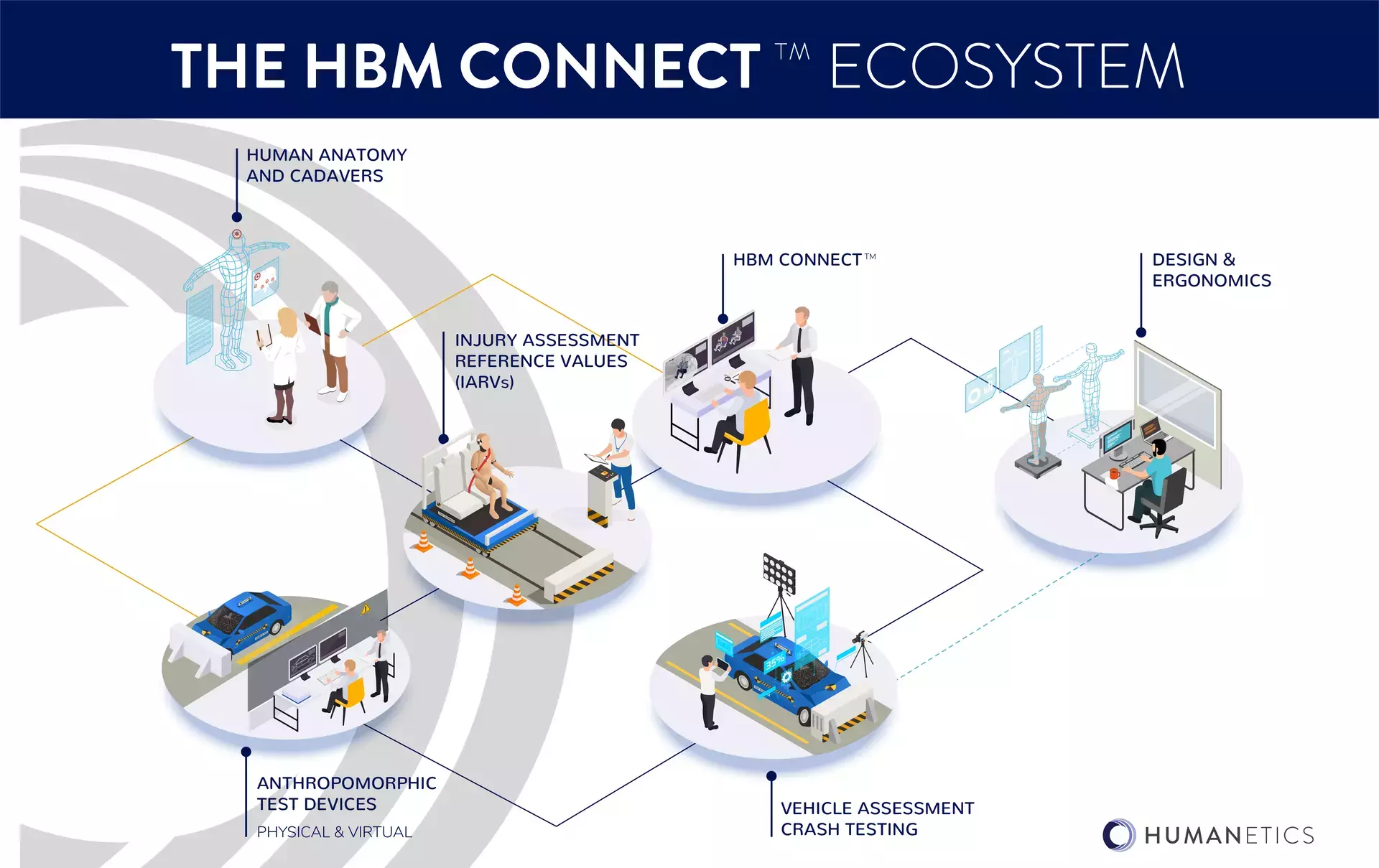
HBM Connect® - The New Analysis Paradigm

Humans in Motion is not just a slogan or tagline, but more of an exemplification of what we study at Humanetics. We explore how crash dynamics influence both our physical and digital test dummies to engineer new and novel solutions. We continue to advance the discipline of impact data collection with our sensors and acquisition systems. And we even scan thousands of real human beings to assemble critical body size measurements for ergonomics and statistical analysis. All of this in the pursuit of vehicle safety and making lifesaving knowledge accessible to all inhabitants in our connected global ecosystem.
So, in keeping with our principles and expanding our available toolsets, we have developed and released our Human Body Model, HBM Connect®. Let’s find out why customers are choosing HBM Connect® to help increase their safety simulations and speed up their safety processes.
First, we will explore some of the significant benefits to incorporating HBM Connect™ into your simulation routines. These include:
- Reducing runtime and computing time up to 40%
- An ATD-like HBM model that is developed to assess and predict injury, unlike others which are for R&D use
- High biofidelity based on our large body scan database and our expertise in the physical to virtual ecosystem
- NCAP and regulator-ready for adoption into protocols
- HBM Connect™ has a connection to ergonomics which can help reduce time to market
What value do Human Body Models bring to the safety and ergonomics worlds?
To begin with, at their core, digital human body models are virtual representations of the human body that are used to simulate various physiological processes and reactions. These models are typically created through a combination of anatomical data, medical imaging, and computer algorithms, and can be used in a variety of contexts to study a wide range of phenomena, from how medical implants and devices react to tissue, to the effects of different types of physical exertion, and to impact injury risk and prediction.
body that are used to simulate various physiological processes and reactions. These models are typically created through a combination of anatomical data, medical imaging, and computer algorithms, and can be used in a variety of contexts to study a wide range of phenomena, from how medical implants and devices react to tissue, to the effects of different types of physical exertion, and to impact injury risk and prediction.
In our Humanetics shared field of design, they enable engineers to simulate and analyze the behavior of the human body during a crash or other impact event. By using human body models engineers can better understand how different vehicle designs and safety systems will affect the human body and make informed decisions about how to optimize those systems. This not only saves time and resources compared to traditional testing methods, but also allows for a more detailed and accurate analysis.
By using human body models engineers can better understand how different vehicle designs and safety systems will affect the human body and make informed decisions about how to optimize those systems.
New Car Assessment Protocols using HBM’s are on the Near-Term Roadmaps
A significant development within the virtual testing world is that progressive vehicle ratings programs like Euro NCAP and C-NCAP are now introducing virtual testing with Human Body Models and will begin their monitoring as soon as 2026, making it mandatory before the decade is out. This is a clear signal of the importance of body models in the fabric of future evaluations of vehicle safety. We’ve historically aligned virtual evaluation with the physical ATDs in crash testing to decrease fatalities, but the desire to get more data and clarity on human injury parameters is requiring greater modeling of body dynamics and frailties. HBMs like HBM Connect® fill this need to advance our understanding and supply data for the design process.
...progressive vehicle ratings programs like Euro NCAP and C-NCAP are now introducing virtual testing with Human Body Models and will begin their monitoring as soon as 2026.
What are the benefits of using HBM Connect® ?

HBM Connect® was designed with product engineers in mind. Its speed and focused application are especially significant qualities derived from what is important to the simulation community as they develop new safety products and navigate new virtual requirements from regulatory bodies and ratings organizations such as global NCAPs.
Unlike other HBMs on the market, which are R&D focused, HBM Connect® was developed to assess and predict injury for safety and commercial purposes. It also has advanced integration and stability with other compatible simulation tools, such as vehicle crash simulation software and occupant restraint system simulation tools.
The omnidirectional, biofidelic, and user-friendly (dummy-like) use of HBM Connect® together with the APT Connect® positioning tool, easily provides super-fast, reproducible, error-free, and ergonomically correct positioning. Its ease of positioning and focus on critical body elements subject to impact will help save 25-40% on overall run time.
One simulation engineer beta tester at a global automotive OEM stated, “HBM Connect® is robust, efficient and very easy to position.”
Humanetics and its partners have validated HBM Connect® against real-world crash data to ensure that it accurately predicts the behavior of the human body during an event by collecting and analyzing crash data from actual accidents and comparing the results to the simulation data.
And let’s not forget to mention that HBM Connect® seamlessly links to the world’s leading 3D CAD manikin, RAMSIS, to transfer occupant posture, predict where occupants will sit in a vehicle, and enables ergonomic data application for realistic human interaction simulations. This functionality also helps us develop more specialized models that are tailored to specific populations such as elderly drivers or pregnant women along with various impact scenarios by utilizing the largest body scan libraries in the world.

Why Humanetics?
Humanetics Safety and Digital has an established reputation as an innovator in automotive safety testing and crash test dummy design. Our teams have a deep understanding of the physics of crash testing and the behavior of human bodies during impact events. This knowledge and experience have been applied to our development of a human body model, allowing us to create a more accurate and realistic digital replica that better simulates real-world crash scenarios.
Our seventy-year long history of developing and testing crash test dummies has also given us a unique perspective on the limitations and challenges of physical testing. By leveraging our experience with crash test dummies and our expertise in advanced modeling and simulation techniques, Humanetics can support a digital human body model that can save 25-40% on run time and provide advantages in the ease of positioning compared to other candidates.
But building an improved human body model also necessitates challenges to increase their usability and accuracy. Our understanding and proficiency provide a basis to persist in our pursuit of body models that are more precise and useful tools for integrating ergonomics with safety processes that can work with HBMs.
What does HBM Connect® mean to us and everyone who uses it?
HBM Connect® means a stability, ease of use, and a tangible level of accuracy we can count on to help validate the work of anyone who uses it. We see it as an ideal tool for industries such as automotive, aerospace, and manufacturing. Its intuitive interface and advanced features bring an efficient analysis of safety and ergonomics, ensuring that products and designs are an optimized validation of human performance in critical environments.

Mark Brown
Mark is the Product Marketing Manager at Humanetics Safety and works closely with Engineering and Sales to develop and refine content that is both useful and informative for our industry. With over two decades of experience in crash test dummy product Quality, Technical, Sales, and Marketing, Mark produces a wide range of media and publications including our service bulletins, webinars, editorial articles, and contributes to our marketing collateral.
